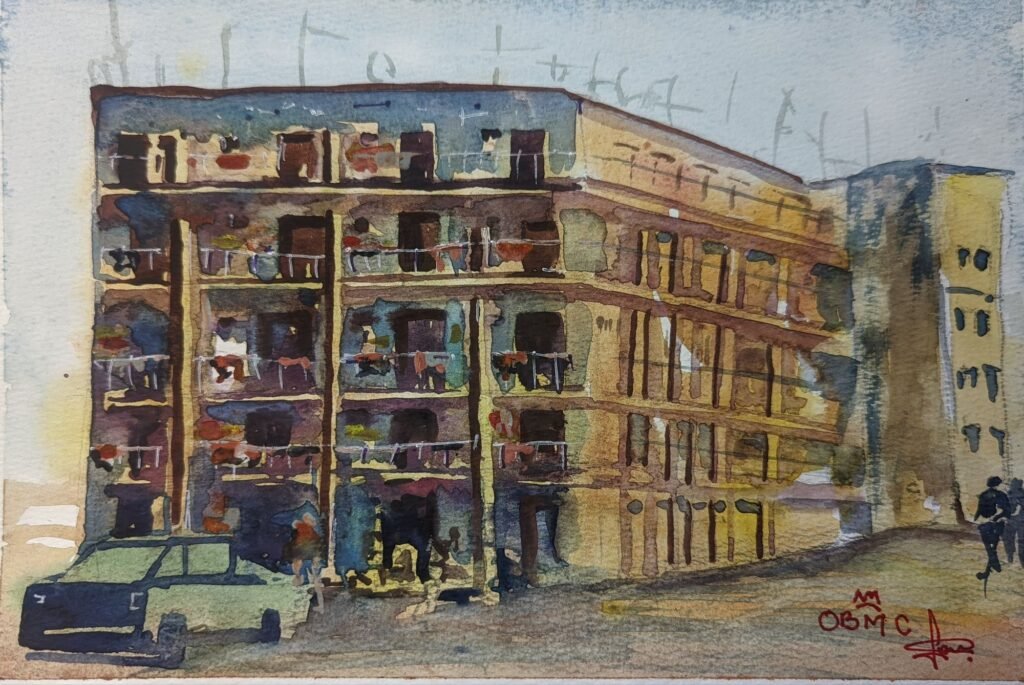
The Artwork: A Glimpse into “Civil Barrack”
The watercolor painting “Civil Barrack” by OBMC is a hauntingly beautiful portrayal of urban overpopulation, capturing the gritty reality of life in a multi-story residential building. Rendered in muted earth tones of brown, ochre, and gray, with subtle accents of blue and red, the artwork exudes a sense of weariness and resilience. The building dominates the frame, its weathered facade marked by cracked walls and sagging balconies, each one cluttered with laundry, pots, and the odds and ends of daily life. The structure’s windows, dark and uneven, seem to peer out like tired eyes, while the faded sky above casts a melancholic glow over the scene. On the ground level, a lone green car sits parked, and a few silhouetted figures—two walking, one standing—hint at the constant movement of residents. OBMC’s loose, expressive brushstrokes and the soft, washed-out palette evoke a profound sense of struggle, yet there’s a quiet dignity in the scene, a testament to the endurance of those who call this place home. The artist’s signature, “OBMC,” is scrawled in red at the bottom right, a subtle mark of ownership over this poignant narrative.
The Story of the Building: A Haven of Last Resort
“Civil Barrack” tells the story of a building that stands as both a refuge and a burden for its residents. Located in a bustling, overpopulated city, this multi-story structure houses dozens of families and individuals, all squeezed into tiny, subdivided units. The residents share a single, overused toilet, a grim symbol of their limited resources and the compromises they’ve made to survive. The air buzzes with the sounds of daily life—children laughing or crying, neighbors shouting over the din, and the clatter of shared cooking spaces. Laundry hangs from every balcony, fluttering like flags of resilience in the dusty breeze. Despite the chaos, there’s an unspoken camaraderie among the tenants, a bond forged through shared hardship. This building, though dilapidated, is their last bastion against homelessness, a place where they cling to hope amid adversity.
Hardships That Lead to Such Living Conditions
The residents of this “civil barrack” have been driven here by a myriad of systemic and personal challenges. Many are rural migrants who arrived in the city with dreams of better opportunities, only to be met with low-wage jobs and unaffordable rents. Economic instability, unemployment, or displacement due to conflict or natural disasters may have forced them into this overcrowded space. For others, it’s the result of generational poverty, where affordable housing is a distant dream, and government support is either inadequate or entirely absent. Some residents might be single parents, struggling to provide for their children, while others are young adults unable to break free from the cycle of poverty. Renting a space in such a building, despite its deplorable conditions, becomes their only viable option to keep a roof over their heads.
The Daily Struggles of Overpopulated Living
Living in such an overpopulated building comes with a litany of challenges that test the residents’ endurance daily:
- Sanitation and Health Risks: Sharing a single toilet among dozens of people leads to unsanitary conditions. The lack of proper plumbing and waste management increases the risk of diseases like cholera or dysentery. Clean water is a luxury, and residents often spend hours queuing just to bathe or wash dishes, their dignity eroded by the constant struggle for basic hygiene.
- Lack of Privacy and Space: Privacy is a foreign concept here. Families live in cramped rooms, often separated by thin walls or makeshift curtains. The constant noise—babies crying, arguments erupting, pots clanging—makes restful sleep a rarity. This lack of personal space takes a toll on mental health, fostering stress, anxiety, and sometimes resentment among neighbors.
- Resource Scarcity and Unreliability: Basic necessities like electricity, water, and cooking gas are either rationed or unreliable. Power outages plunge the building into darkness for hours, while a single shared stove means long waits to cook meals. These shortages often lead to tension, as residents compete for limited resources, yet they also learn to share what little they have.
- Safety Hazards: The building’s dilapidated state poses constant dangers. Crumbling walls, exposed wiring, and overcrowded balconies risk collapse or fire hazards. Theft and petty crime are rife, as desperation drives some to take from their neighbors, further eroding trust within the community.
- Social Stigma and Marginalization: Living in such conditions carries a heavy social stigma. Residents often feel judged by those in better circumstances, their address marking them as “less than.” Children face bullying at school, while adults struggle to find better jobs, as employers associate their living situation with unreliability or poverty.
- Emotional and Psychological Toll: The daily grind of survival weighs heavily on the residents’ spirits. Parents lie awake at night, worrying about how to feed their children, while young adults feel trapped, unable to save enough to escape. The lack of space, resources, and hope fosters a pervasive sense of helplessness, yet many find ways to endure, drawing strength from their community.
Resilience Amid Adversity
Despite these hardships, the residents of this “civil barrack” display remarkable resilience. They share meals, take turns looking after each other’s children, and find moments of joy in small gatherings on the balconies or in the dusty courtyard below. The building, though a symbol of struggle, also stands as a testament to human endurance and the will to survive against overwhelming odds. OBMC’s painting captures this duality—the weight of hardship and the quiet strength of those who call this place home. Through their shared experiences, the residents forge a community that, while imperfect, offers a glimmer of hope in an otherwise unforgiving world.
1 Comment
Abdulrahman Aderibigbe · May 16, 2025 at 9:57 pm
AWESOME